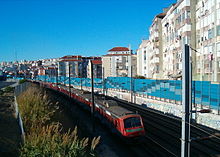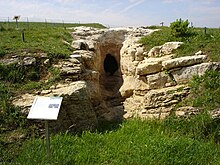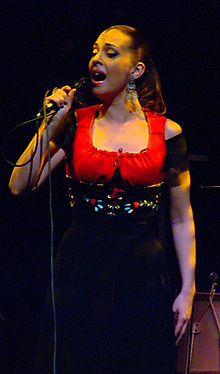Amadora
| Amadora | ||||||
|---|---|---|---|---|---|---|
|
||||||
| Basic data | ||||||
| Region : | Lisboa | |||||
| Sub-region : | Lisbon metropolitan area | |||||
| District : | Lisbon | |||||
| Concelho : | Amadora | |||||
| Coordinates : | 38 ° 45 ′ N , 9 ° 14 ′ W | |||||
| Residents: | 9835 (as of June 30, 2011) | |||||
| Surface: | 1.34 km² (as of January 1, 2010) | |||||
| Population density : | 7340 inhabitants per km² | |||||
| Amadora County | ||||||
|
||||||
| Residents: | 175,136 (as of June 30, 2011) | |||||
| Surface: | 23.78 km² (as of January 1, 2010) | |||||
| Population density : | 7365 inhabitants per km² | |||||
| Number of municipalities : | 6th | |||||
| administration | ||||||
| Administration address: | Câmara Municipal da Amadora Av. Movimento das Forças Armadas 2700 Amadora |
|||||
| President of the Câmara Municipal: | Joaquim Moreira Raposo ( PS ) | |||||
| Website: | www.cm-amadora.pt | |||||
Amadora [ ɐmɐˈdoɾɐ ] is a city (or a município ) in Portugal , which belongs to the Lisbon District , the Lisboa e Vale do Tejo region and the Greater Lisbon sub - region. It has over 175,000 inhabitants (2011). Amadora is a suburb of Lisbon and is inhabited by many commuters who work in Lisbon.
history
A large number of archaeological excavations prove the settlement since the Paleolithic , through the Neolithic tombs of Carenque and finds from the Copper , Bronze and Iron Ages , to traces of the Roman occupation up to the 3rd / 4th. Century AD, such as the Roman aqueduct.
From the 15th to around the 17th century, various wealthy families settled here and built estates, attracted by the fertile fields, the quiet of the countryside and the proximity to the capital. As a result of the construction of the Aqueduto das Águas Livres in 1732 , the population continued to grow, as did the number of streets and the first industrial establishments. At the beginning of the 20th century, a group of citizens wanted to create a garden city ( Portuguese : Cidade jardim ), which should bring the structures of a city together with nature as a preventative measure. The previous main town of the municipality, Porcalhota (dt. About: Die Schweinige), was renamed Amadora in 1907 by King Carlos I , at the endeavor of the population. From 1909 to 1916 Amadora experienced a significant development that further raised the standard of living of the resident population. In 1916 Amadora became an independent municipality in the Oeiras district . The industrial development of Amadora continued to grow, and workers were increasingly living here. The rapid growth of the place now overtook all considerations of urban planning.
In 1937 Amadora was elevated to a Vila (small town), and its population continued to grow rapidly until 1950. In 1979 the place was elevated to a cidade (city), and in the same year, as the first newly created circle after the Carnation Revolution in Portugal, the seat of an independent circle ( concelho ).
administration
circle
The concelho (urban district) Amadora is one of the smallest in Portugal with an area of 23.77 km² and the most densely populated. It is divided into six parishes ( freguesias ). Neighboring districts are Odivelas in the northeast, Lisbon in the southeast, Oeiras in the south and west and Sintra in the west and north.
The municipalities of Amadora County are:
| local community | Population (2011) |
Area km² |
Density of population / km² |
LAU code |
|---|---|---|---|---|
| Águas Livres | 37,426 | 2.21 | 16,913 | 111513 |
| Alfragid | 17,044 | 2.51 | 6,787 | 111512 |
| Encosta do Sol | 28,261 | 2.80 | 10,086 | 111514 |
| Falagueira-Venda Nova | 23,186 | 2.86 | 8,114 | 111515 |
| Mina de Água | 43,927 | 8.09 | 5,428 | 111516 |
| Venteira | 25,292 | 5.31 | 4,764 | 111517 |
| Amadora County | 175.136 | 23.78 | 7,365 | 1115 |

Population development
| Population in Amadora County (1981-2011) | ||||
|---|---|---|---|---|
| 1981 | 1991 | 2001 | 2011 | |
| 163 878 | 181 774 | 175 872 | 175 558 | |
Municipal holiday
- September 11
Town twinning
-
 Cape Verde : Tarrafal (since 1989)
Cape Verde : Tarrafal (since 1989) -
 Angola : Huambo (since 1999)
Angola : Huambo (since 1999) -
 Brazil : Piracicaba (since 2000)
Brazil : Piracicaba (since 2000)
Personalities
sons and daughters of the town
- Beata Maria Clara do Menino Jesus (1843–1899), beatified nun
- Ruy Roque Gameiro (1906–1935), sculptor
- Cruzeiro Seixas (* 1920), painter, poet, activist of surrealism
- Vasco Callixto (* 1925), journalist, author in particular of travel and motorsport literature
- Maria José Valério (born 1933), singer
- Luís Mira Amaral (* 1945), engineer, manager and politician, multiple minister
- António Garcia Barreto (* 1948), writer
- Jorge Jesus (* 1954), football coach
- Rogério Samora (born 1958), actor
- Rui Guilhoto Loureiro (* 1960), psychologist, university professor, researcher and author
- João Baião (* 1963), actor and television presenter
- José Miguel Ribeiro (born 1966), director
- Teresa Salgueiro (born 1969), singer
- Rui Costa (born 1972), football player
- Carla Chambel (* 1976), actress
- Valete (born 1981), rapper
- Ricardo André (* 1982), football player
- João Vítor Rocha de Carvalho Moreira (* 1986), football player
- Nani (* 1986), soccer player
- Diogo Salomão (* 1988), football player
- Rúben Semedo (* 1994), football player
- Renato Júnior Luz Sanches (born 1997), football player
Associated with Amadora
The Portuguese national soccer player Luís Carlos Almeida da Cunha, or Nani for short , lives in Amadora.
The internationally known music group Buraka Som Sistema was founded in 2006 in Buraca, a district of Amadora.
Sports
The professional soccer team of CF Estrela Amadora is the most famous sports club in the city. He plays his home games in the 12,630-seat Estádio José Gomes stadium . After playing for many years in the first division, the Primeira Liga , and even winning the national cup with the Taça de Portugal in 1990 , the club experienced a decline in the 2000s that reached a low point with the temporary full suspension after 2010. However, his youth teams continue to participate in the game. Other sports that are practiced in the club are table tennis, fencing and sport fishing. Futsal is no longer practiced here.
economy
A large number of companies are located in the district, including industrial, logistics, software and trading companies, publishers (including Editorial Caminho ), and shopping centers, e.g. B. IKEA and the 122,000 m² Dolce Vita Tejo, one of the largest shopping centers in Europe . Several companies have their Portuguese headquarters here, including Siemens and Hoffmann-La Roche .
From 1943 until its closure in 2005, Amadora was the location of the railway manufacturer Sorefame .
traffic

Road traffic
Amadora lies within a triangle of three trunk roads: the IC19 ( Lisbon - Sintra ), the IC16 (Lisbon - Moinhos da Funcheira ) and the A9 motorway .
Public transportation
Amadora is located on the Linha de Sintra and has three train stations and stops on it: Amadora , Reboleira and Santa Cruz - Damaia . In addition, the Linha Azul of the Lisbon Metro runs to Amadora and ends at the Reboleira stop. In the future, the line is to be extended further through the city center ( Amadora Centro ) to the Amadora-Sintra Hospital .
See also
Web links
- City website
- Photos by AMADORA
Individual evidence
- ↑ www.ine.pt - indicator resident population by place of residence and sex; Decennial in the database of the Instituto Nacional de Estatística
- ↑ a b Overview of code assignments from Freguesias on epp.eurostat.ec.europa.eu
- ↑ http://psamadora.blogs.sapo.pt/54734.html
- ↑ www.ine.pt - indicator resident population by place of residence and sex; Decennial in the database of the Instituto Nacional de Estatística
- ↑ www.verportugal.net , accessed on February 24, 2013
- ↑ www.anmp.pt , accessed on February 24, 2013
- ↑ Archived copy ( Memento from August 3, 2012 in the web archive archive.today )












